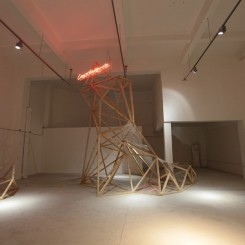“The 7th Shenzhen Sculpture Biennale — Accidental Message: Art is Not a System, Not a World (偶然的信息:艺术不是一个体系,也不是一个世界).” Curated by Liu Ding, Carol Yinghua Lu and Su Wei.
OCT Contemporary Art Terminal (OCAT) (OCAT Hall A/B & B10, OCT-LOFT, Enping Road, Overseas Chinese Town, Shenzhen, China). May 12 to August 31, 2012.
In its seventh manifestation since its inception in 1998, the “Shenzhen International Contemporary Sculpture Exhibition” was this year renamed the “Shenzhen Sculpture Biennale.” This can be seen as an instrumental turning point in the exhibition’s development as, for the first time, it took on one strategy of International Biennale exhibition models — the appointment of a curatorial team to oversee its conceptual and academic organisation. “Accidental Message: Art is Not a System, Not a World” provided a critical visual presentation of the curators’ thinking and judgements about the value of art systems by focusing on mechanisms of artistic and curatorial production and infrastructures, the development of the criticality of Chinese art and the construction of art historical knowledge, and the economic implications and commercialization of art, through ultimately questioning social order and power games in the art world. In part, it was a clear continuation in more analytical terms of Liu and Lu’s project “Little Movements: Self-practice in Contemporary Art,” initiated in 2010 and also on display at OCAT last year, which similarly examined new modes of thinking and working in artistic and theoretical practices between individual artists, small artist collectives, institutions, publishing, art history writing, and education, in local, national to international contexts, from past to present.
“Accidental Message” was clearly defined between two modes of curatorial thought, that of “Unexpected Encounters,” defining examples of Chinese art from the 1990s, and of “What You See is What I See,” the curatorial team’s recent engagement over the past few years with Chinese and international artists. Together, they are presented alongside a handful of works installed in the sub-tropical outdoor landscape of the OCT-LOFT district to bring the exhibition’s context further into the public domain. It became a show less about comparisons and dialogues between sculptures, or sculptures and other works — largely new media of which there was a strong digital, sound art and moving image faction to the show — and more of an opportunity to see how the creative international networks between the three emerging Chinese curators and over 50 artists, including the representation of their personal attitudes and belief systems, were put into a physical reality for viewers to deconstruct and interpret. This is done in an attempt to encourage disruption within the art system yet in turn reaffirm and exemplify their inherent status. It was only within the newly implemented construct of the Biennale that this level of inquiry can take place, thus a fluid and necessary decision for the sculpture exhibition’s organizers to move it into a more contemporary mindset in relation to contemporary art and curatorial practice today.
The inclusion of established, deemed “blockbuster” artists from China as part of “Unexpected Encounters” acted as a minimal reference point to the socio-art historical contexts presented in the exhibition, and like the rebranding of the sculpture exhibition itself, further emphasized the economic and commercial value of contemporary art, specifically the unavoidable power struggles that exist within contemporary Chinese art. On one hand, this could be seen as a contradictory notion to the exhibition’s overall concept as it explicitly embraced the idea of selling out to commercialism; yet conversely, it could be presenting a clever irony, a façade to make you further question and prove the systems that are in play. These observations highlight the establishment of new art systems in the 1980s and early 1990s in China that defined a specific generation of Chinese artists, where these infrastructures through which to practice were not often brought into question. When set in reference to its Western counterpart as within this exhibition, there is an awareness of the dualisms between the development of Eastern and Western art systems and art historical discourse where “What You See is What I See” provided a strong point of departure for critical engagement with the intended curatorial premise. It allowed viewers to delve into new contemporary artworks, of which notable examples are referenced below, to examine this relationship on an individual basis and question its future and place in Chinese and global terms.
Please click on the photo gallery for photos and commentary.
